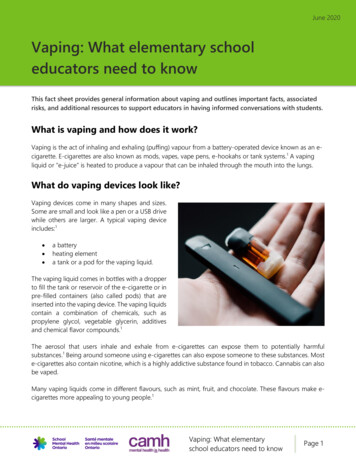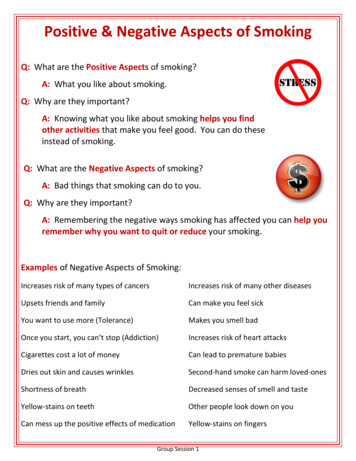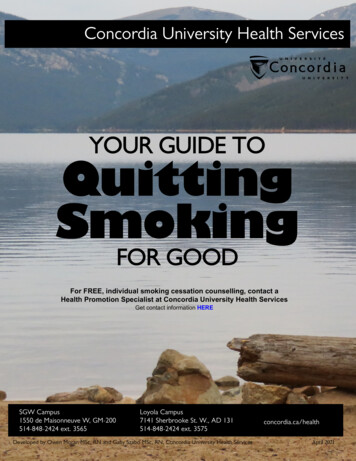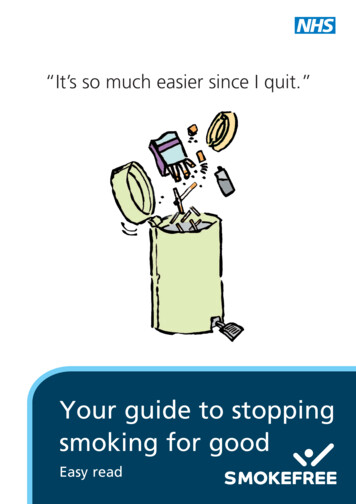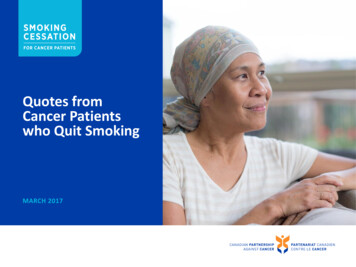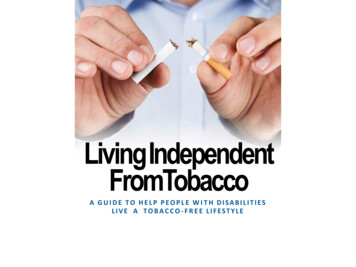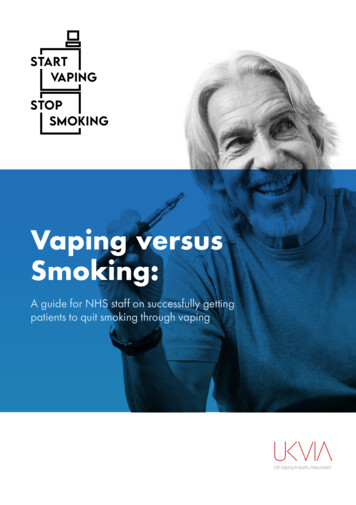
Transcription
STARTVAPiNGSTOPSMOKiNGVaping versusSmoking:A guide for NHS staff on successfully gettingpatients to quit smoking through vaping
Introduction to this guideMore than half a million adult hospital admissions were due to smokingin 2019-20, some 10% higher than a decade earlier (Office of NationalStatistics)[1].The University of East Anglia[2] will conduct trials in NHS hospital truststo encourage patients with smoking illnesses to look at vaping as a wayto help them quit their habits. The communication of accurate, evidencebased information is key for a successful transition from combustibletobacco to e-cigarettes.This simple guide has been compiled by the UK Vaping IndustryAssociation (UKVIA) to support healthcare professionals with up-to-dateinformation (found within PHE’s online guidance on e-cigarettes), so thatyou can provide accurate facts to your patients. It will provide patientsthe reassurance and confidence to be able to break away from smoking.We have included common questions that smokers ask when they areconsidering vaping and other quit methods. Evidence sources are includedwhere relevant.Good luck with supporting your patients who smoke on their quitjourney.For more information visit: www.ukvia.co.uk/healthcarehub[1][2]2ONS, Adult Smoking Habits in the UK [Link]University of East Anglia, Starter vape packs to be handed out in hospitals, [Link]
Your common vaping questions answeredQ: How does vaping compare to smoking in terms of risk?A: Vaping isn’t completely risk free, but it poses a small fraction of the health riskof smoking. According to PHE, in its vaping evidence review, it is at least 95%less harmful than smoking[3]. Cancer Research UK also states that evidence so farindicates that e-cigarettes are far less harmful than smoking as they don’t containtobacco or involve combustion.Q: Why is smoking so much more harmful than vaping?A: Cigarette smoke contains thousands of distinct constituents, many of whichare toxic or carcinogenic. It is these toxic by-products of combustion that areresponsible for smoking-related death and disease. Vaping does not involveburning tobacco and doesn’t produce tar or carbon monoxide.E-cigarettes do not burn tobacco leaves but use electronic heat sources toaerosolise a nicotine-containing liquid that is then inhaled by the user. Thisprovides nicotine without burning tobacco, thus significantly reducing exposure tothe harmful chemicals found in tobacco smoke.Although nicotine is the reason people become addicted to smoking, it is thethousands of other chemicals contained in cigarette smoke that cause almost all ofthe harm.Q: How does vaping work?A: Vape devices run on batteries and heat up e-liquids into vapour, which isinhaled and exhaled from the mouthpiece of the device. E-liquids are made up ofhandful ingredients, including nicotine. The concentration of nicotine in the e-liquidcan be varied, allowing vapers to decide the right strength for themselves.[3]PHE, 2015 E-cigarette Evidence Review, [Link]3
Q: Is it easy to quit using vaping?A: Vaping is one of the most effective quit aids available, helping around 50,000smokers quit a year[4]. The experience of completely switching to e-cigarettesvaries for different people and can depend on how many cigarettes they smokedper day. Steps that will support patients include visiting a vape shop, where theywill receive support on what strength of e-liquid is most appropriate.In the beginning, patients may find that they cough when inhaling vapour whichis common. Vapour is different to smoke but with the support of a vape shop orvaping friends this should pass.Q: How can I ensure a successful quit using vaping?A: The UKVIA Vaping to Quit Smoking Guide highlights how patients whosmoke can choose the best devices, nicotine levels and flavours to give themthe best chance of a successful quit. Visiting local stop smoking services or bydownloading the Smoke Free App.Q: Where can I find out more about vaping and other alternatives tosmoking to help me quit?A: There are many organisations providing advice to smokers looking to quit. It’swell worth taking a look at a range of sources, including the likes of Stop SmokingServices, Public Health England, the Smoke Free app, Smokefree NHS, the UKGovernment website, pharmacies and vape retail stores. The UKVIA smokereducation campaign, VApril also has a dedicated website at www.vapril.org anda section offering advice and information to smokers at www.ukvia.co.uk.Q: What if I don’t take to vaping, what are the other alternatives?A: Those looking to quit smoking will need to determine what’s the bestmethod or combination for them. There are other quit methods such as gum,patches, heat not burn and other nicotine replacement therapies (NRTs) thatpeople use successfully.[4]4PHE, 2021, Seventh report on vaping in England, [Link]
Some may also combine these tools with vaping. However, vaping is now widelyrecognised as the most successful tool to quit smoking and consistently studiesshow it to be much more effective than other NRTs.[5]Q: If I start vaping can it cause harm to my families and friends in thesame way as passive smoking?A: Existing evidence suggests that exhaled vapour is not harmful to others and therisk to bystanders is low to very low according to the Committee of Toxicology.This is in direct contrast to secondhand smoke which is harmful.Q: I’ve seen a lot of negative publicity about vaping – I’m not surewhether to believe it or not?A: Public Health England stated in its 2020 version of its Vaping Evidence Reviewthat perceptions of harm from vaping among smokers are increasingly out of linewith the evidence[6]. There have been a lot of misleading stories about vapingthe in the media, none more so than the news two years ago in the US aboutan outbreak of serious lung injuries which were reportedly caused by vaping.However US authorities identified that vitamin E acetate, added to cannabisproducts, were the “primary cause” of the outbreak. Vitamin E acetate is bannedfrom UK regulated nicotine-containing e-cigarettes. Likewise, there have beenreports that vaping causes the lung condition, called ‘popcorn lung’. CancerResearch UK categorically says on its website that there is no link between thecondition and vaping[7].To date there have been no conclusively confirmed deaths in the UK from vapinglegal products and recently the Royal College of Physicians released a majorreport calling for the UK government to promote electronic cigarettes via a massmedia campaign[8].A Randomized Trial of E-Cigarettes versus Nicotine-Replacement Therapy, Peter Hajek et. al., 2019, [Link]PHE, 2021, Seventh report on vaping in England, [Link][7]Cancer Research UK, 2019, Does vaping cause popcorn lung? [Link][8]RCP, 2021, Smoking and health, [Link][5][6]5
Q: Is it easy to quit using vaping? A: Vaping is one of the most effective quit aids available, helping around 50,000 smokers quit a year[4]. The experience of completely switching to e-cigarettes varies for different people and can depend on how many cigarettes they smoked per day.
